#ankylosauridae
Text
Seems this Tarchia found the dino cam hidden in her enclosure!
#tarchia#dinosaur#palaeoblr#paleontology#ankylosaurus#ankylosauridae#video#blender#blender3d#b3d#art#artists on tumblr#animation#ornithischia#animator#animated#cgi#3d model#3d art#my art#3d artist
5K notes
·
View notes
Text
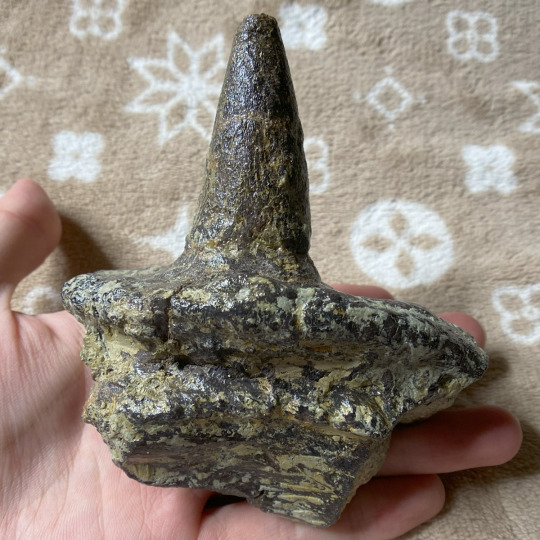
A fossilized dermal spike of a Spicomellus afer from the El Mers Group in Boulahfa, Boulemane, Morocco. Prior to description, the odd spikes of these basal ankylosaurs were not considered dinosaurian in nature often treated as an odd turtle or crocodylomorph. While spikes are common amongst thyreophoran dinosaurs, the osteoderms in Spicomellus were strangely fused to their ribs.
#dinosaur#fossils#paleontology#palaeontology#paleo#palaeo#spicomellus#thyreophoran#ankylosauridae#nodosauridae#ornithischian#jurassic#mesozoic#prehistoric#science#paleoblr#スピコメルス#アンキロサウルス科#ノドサウルス科#恐竜#化石#古生物学
22 notes
·
View notes
Text
Should I turn my page into a dinosaur dictionary? I know so much about dinosaurs
#dinosaur#dinos#lgbtq#autism#dinosaurs#gay dinosaurs#fun facts#memes#parasaur#parasaurolophus#ankylosauridae#ankylosaurus#prehistoric#mesozoic#jurassic#questions#too many hashtags
26 notes
·
View notes
Text

Borealopelta is a Pretty Neat Ankylosaur
(really wish i got the sauropelta...)
#jurassic park#dinosaurs#dinosaur toys#jurassic word#ankylosaurs#ankylosauria#palaeontology#dominion#jurassic world dominion#borealopelta#ankylosaurid#ankylosauridae#toy photography#jurassic world mattel#jurassic park mattel#dinosaur#jurassic world fallen kingdom#fallen kingdom#ankylosaur#dino trackers
7 notes
·
View notes
Text
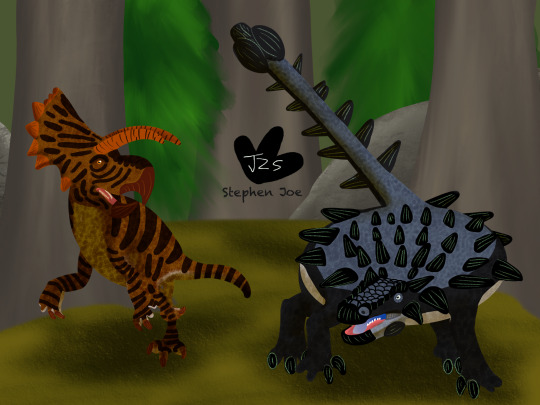
Day 8: Zuul
Ankylosaurid Zuul is harassed and chased a ceratopsid Furcatoceratops away.
And yes, this is new ceratopsid is officially published who once called “Ava” or even referred as “Malta New Taxon” is given a name means “Forked horn face” Furcatoceratops.
#Judith River July#my art#dinosaur#paleoart#dinosaurs#myart#dinosauria#my drawings#procreate#ornithischia#ankylosauridae#zuul#ceratopsidae#furcatoceratops#artists on tumblr
6 notes
·
View notes
Text
Dinofact #38
Despite its position as the most well-known ankylosaurid, as well as being considered the archetypal member of ankylosauria, Ankylosaurus had some unusual features. It was among the last non-avian dinosaurs, and was possibly the largest known ankylosaurid, measuring 6 to 8 meters (20 to 26 feet) long and weighing 4.8 to 8 metric tons (5.3 to 8.i short tons). Additionally, unlike other ankylosaurs, its nostrils faced sideways, rather than to the front.
Source: wikipedia
#dinosaur#dinosaurs#paleontology#ankylosaurus#ankylosaurid#ankylosaurids#ankylosauria#ankylosauridae#fun facts#trivia#dinosaur trivia#dinosaur fun facts#1st#october#2022#october 1st#october 2022#october 1st 2022
24 notes
·
View notes
Text
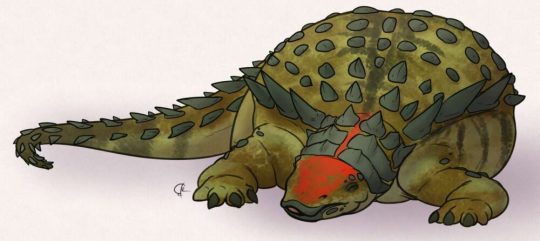
Texasetes
Texasetes (що означає «житель Техасу») — рід динозаврів-анкілозаврів з пізньої нижньої крейди Північної Америки. Цей маловідомий рід був знайдений в формації Paw Paw (пізній альбський вік) поблизу Хаслета, округ Таррант, штат Техас, звідси також відомий анкілозавр-нодозаврид Pawpawsaurus.
Повний текст на сайті "Вимерлий світ":
https://extinctworld.in.ua/texasetes/
#texasetes#ankylosauridae#dinosaur#cretaceous#north america#usa#texas#paw paw#late cretaceous#cretaceous period#dinosaurs#pawpawsaurus#paleoart#paleontology#prehistory#extinct animals#палеоарт#палеонтологія#вимерлі тварини#доісторичні тварини#ukraine#ukrainian#scientific illustration#art#scientific article#history#animals#creatures#україна#українська мова
8 notes
·
View notes
Note
Favourite dinosaur top ten go!
Noone's asked me that since 1998, uhhh I'm pretty basic and I'll give you five.
Parasaurolophus
Ankylosauridae in general
Pteranodon
Stegosaurus
Triceratops
Denver, the last
I just think they're funky lil guys
35 notes
·
View notes
Note
may I know about paleobiology? (also what's the difference between it and paleontology)
The difference isn't extremely clear but paleobiology is a school OF paleontological study that specifies the study of ancient life and its functions- which is different from paleogeology and paleoanthropology, and is a category that contains paleobotany as well (specifically ancient plants). So here are some of my favorite assorted paleobiological facts (+ a bonus paleogeological one!)
Dinosaurs are separated into two groups based on the structure of their pelvises- Ornithiscians (bird hipped) and Sauriscians (lizard hipped). In what I believe to be the funniest oversight in the entire study, modern manoraptors, i.e. birds, are Sauriscians.
In a fairly recent dig, evidence of a larynx was found among fossils in the family ankylosauridae. This implies that at least Ankylosauridae, but more than likely many OTHER dinosaurs, were capable of complex calls in the same manner birds are. This was already commonly theorized, but this proof is very exciting!
Ginkgo trees are some of the oldest trees still living on our planet, and have remained largely unchanged since they first arrived around 290 million years ago.
A slightly gross to some, but super informative fossil is known as Coprolite- fossilized feces, essentially. They're a great insight into what it is ancient creatures ate!
Bonus paleogeological fact! The appalachain mountains are around 480 million years old... which makes them older than the first known vertebrates! That's an ancient mountain...
#austinwehaveaproblem#ask#ty so much for you interest !!!#yall are also allowed to infodump in my ask box idm
13 notes
·
View notes
Text


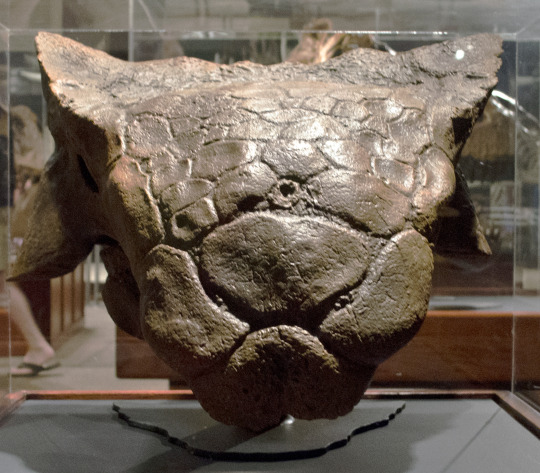


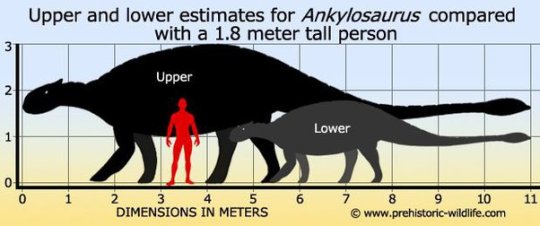
Ankylosaurus magniventris
(temporal range: 68-66 mio. years ago)
[text from the Wikipedia article, see also link above]
Ankylosaurus[nb 1] is a genus of armored dinosaur. Its fossils have been found in geological formations dating to the very end of the Cretaceous Period, about 68–66 million years ago, in western North America, making it among the last of the non-avian dinosaurs. It was named by Barnum Brown in 1908; it is monotypic, containing only A. magniventris. The generic name means "fused" or "bent lizard", and the specific name means "great belly". A handful of specimens have been excavated to date, but a complete skeleton has not been discovered. Though other members of Ankylosauria are represented by more extensive fossil material, Ankylosaurus is often considered the archetypal member of its group, despite having some unusual features.
Possibly the largest-known ankylosaurid, Ankylosaurus is estimated to have been between 6 and 8 meters (20 and 26 ft) long and to have weighed between 4.8 and 8 metric tons (5.3 and 8.8 short tons). It was quadrupedal, with a broad, robust body. It had a wide, low skull, with two horns pointing backward from the back of the head, and two horns below these that pointed backward and down. Unlike other ankylosaurs, its nostrils faced sideways rather than towards the front. The front part of the jaws was covered in a beak, with rows of small, leaf-shaped teeth farther behind it. It was covered in armor plates, or osteoderms, with bony half-rings covering the neck, and had a large club on the end of its tail. Bones in the skull and other parts of the body were fused, increasing their strength, and this feature is the source of the genus name.
Ankylosaurus is a member of the family Ankylosauridae, and its closest relatives appear to be Anodontosaurus and Euoplocephalus. Ankylosaurus is thought to have been a slow-moving animal, able to make quick movements when necessary. Its broad muzzle indicates it was a non-selective browser. Sinuses and nasal chambers in the snout may have been for heat and water balance or may have played a role in vocalization. The tail club is thought to have been used in defense against predators or in intraspecific combat. Specimens of Ankylosaurus have been found in the Hell Creek, Lance, Scollard, Frenchman, and Ferris formations, but it appears to have been rare in its environment. Although it lived alongside a nodosaurid ankylosaur, their ranges and ecological niches do not appear to have overlapped, and Ankylosaurus may have inhabited upland areas. Ankylosaurus also lived alongside dinosaurs such as Tyrannosaurus, Triceratops, and Edmontosaurus.
16 notes
·
View notes
Text
Sunday 18/9/22 - Dinosaur Swords and Shields; Thyreophorans
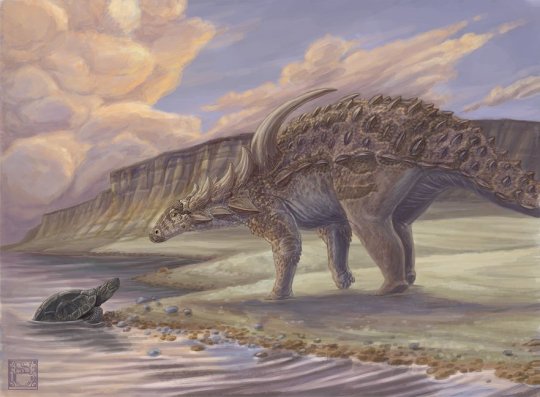
Sauropelta - Sean Closson (twitter)
Apologies in advance if today's article is a bit more scatterbrained than some of my better blogposts in the past, but I've been procrastinating writing for a bit and need to get something out.
The larger group of Dinosauria is traditionally split into two main groups: The Saurischians (lizard hips) and Ornithischians (bird hips). The Saurischians include the Therapods (most meat eaters) and Sauropods (long necks), and have been the focus of a lot of my dinosaur discussion on this blog. So today, I wanna highlight a group from Ornithischia, the Thyreophorans.

Miragaia - TheDinosaurMann (twitter)
Thyreophora includes most of what the public would think of as "Armoured Dinosaurs", and much of the uniting anatomical traits are adapted for a thick set body, weight bearing limbs, powerful tails, and a general predator deterring lifestyle. The earliest and more primitive members of this group were more slender, and evolved from a bipedal common ancestor, but the most derived members were the heaviest, spikiest, and well armoured dinosaurs of their time.

Scutellosaurus, an early Thyreophoran
Gabriel Ugueto/Serpenillus (twitter)
One anatomical trait common to all Thyreophorans is the extensive covering of Osteoderms, bony skin protrusions that decorate and protect the backs, heads, and tails of many members. In the Ankylosaur division, this is mostly present as rounded studs and lumps all along the back and sides of the animal. In Stegosaurs, they present as spikes and plates along the back and tail of the animal. Before researching this topic, it never occurred to me that these were analogous structures, but it makes sense these features had ancestral roots.
To best demonstrate the diversity of Thyreophorans, I want to highlight three of the most recent discovered species from across the group.
Bashanosaurus

@ ttorrooo (on twitter)
This Stegosaur was recently found in China in 2015 and described in 2022. Its name means "Bashan-lizard" Bashan being an old name for Chongqing, where it was discovered. Current research places Bashanosaurus as a very primitive member of the Stegosaur clade, and it shares many traits common with Scelidosaurus, a Thyreophoran thought to have evolved before Stegosaurs and Ankylosaurs diverged.
In later Stegosaurs, the back spines had evolved into angular plates, thought to be primarily a display structure. But in Bashanosaurus, the back spines are still very spiky, and parts of its body still preserve rows of spikes on the side of the body, which were reduced to just one spike on the shoulder or lost altogether in later species. It still had the tail spikes, and this seems to be an ancestral trait. It represents a visual clue on how Stegosaurs evolved some of their more derived traits.
Stegouros

@adamworks (tumblr)
This dinosaur was a very derived Ankylosaur discovered in Chile in 2018, and described in 2021. It's name means "roofed tail". Ankylosaurs were traditionally split into two groups, Ankylosauridae, many of which had tail clubs, and Nodosauridae, which were often heavier built, and lacked tail clubs. These groups were mostly from northern continents, and Ankylosaurs from Australia and Antarctica were harder to classify.
The description of Stegouros prompted the creation of a new division within Ankylosauria; Parankylosauria, a group of Gondwana dinosaurs that diverged earlier, and Euankylosauria, which included the Nodosaurids and Ankylosaurids. While the Northern Continent Ankylosaurs were larger, and utilised clubs in their tail weaponry, Stegouros and its relatives were smaller, less bulky, and Stegouros had a sword on its tail. This tail was less mobile, the "sword" formed from several fused vertebrae, but it was still very dangerous.
Jakapil
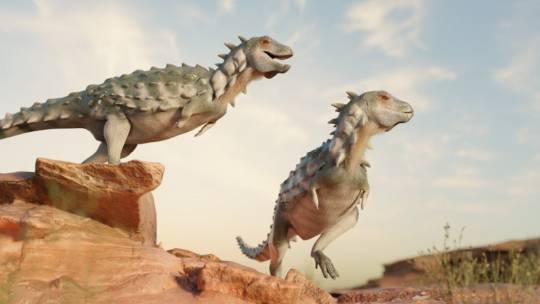
Gabriel Diaz Yantén/ PaleoGDY (on twitter)
Video version linked here
This dinosaur was a basal Thyreophoran discovered in Argentina across the 2010s and described in 2022. Its name means "shield bearer" in the Puelchan language. Jakapil represents a lineage of dinosaurs that split off from the rest of Thyreophora before Stegosaurs and Ankylosaurs even split. But whereas most of the time you'd think "basal" or "primitive" means from an older time, Jakapil was from the Late Cretaceous, after most of the Stegosaur lineage had died out.
Thyreophorans were mostly heavy set animals, so quadrupeal locomotion was the norm, but Jakapil was an obligate biped; its arms were too small to walk on. It's well muscled jaw and unique skull shape has many palaeontologists theorising it was a basal Ceratopsian, but the advanced osteoderm armour/spikes on the neck, shoulders and down the back concluded it was a Thyreophoran. A very unique dinosaur indeed.
Thanks for Reading
Hi, if you haven't read any of my stuff before, thanks for reading this. This is sort of my dive into amateur journalism. This is not a dinosaur blog, but I do talk about dinosaurs a lot, so feel free to check out the links in my Pinned Post.
If you have a suggestion for something dinosaur to talk about, please inbox me, I am starved for creativity and would love the inspiration.
#blog#blogpost#palaeontology#dinosaurs#Thyreophorans#ankylosaurs#stegosaurs#parankylosauria#bashanosaurus#stegouros#jakapil
71 notes
·
View notes
Text

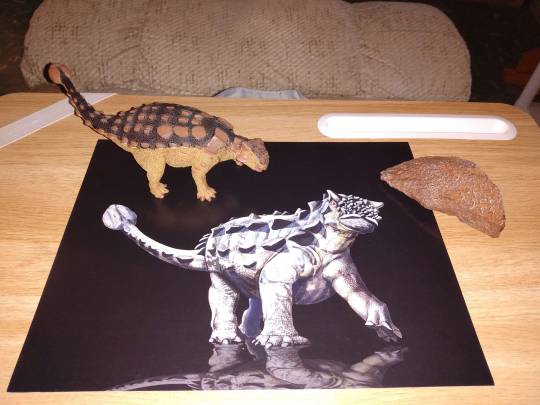
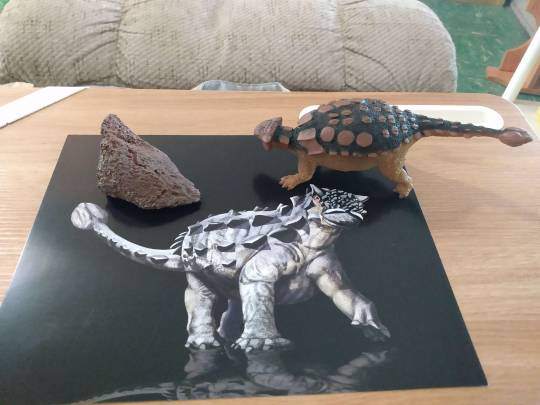


Todays fossil is that of my new ankylosaurus osteoderm. Ankylosaurus is a genus of large armored dinosaur in the Ankylosauridae family that lived throughout Western North America during the Late Cretaceous Period some 70 mya to 66 mya. The first remains of Ankylosaurus were uncovered by an expedition team lead by Barnum Brown digging in the Hell Creek Formation, near Gilbert Creek, Montana in 1906. The specimen consisted of a partial skull, teeth, the shoulder girdle, several vertebrae and ribs, and more than thirty osteoderms. Brown scientifically described the animal in 1908; dubbing the genus Ankylosaurus from the Greek words ankulos ('bent' or 'crooked') and sauros ('lizard'). Since then several more specimens have been recovered including the first and only tail known tail club in 1910 and a remarkably complete skeleton assembled by Kenneth Carpenter in 2004, still however just one species is recognized: A. magniventris. Standing 4 to 6 feet high that the hip, measuring some 18 to 26 feet in length, and weighing up to 8 tons, Ankylosaurus was the largest-known ankylosaurine dinosaur and possibly the largest ankylosaurid to ever live. Osteoderms ran across its top side and particularly large plates covered the shoulder and neck area with smaller pieces in between to allow for movement. The tail club was composed of several overly large osteoderms fused together with the end vertebrae. Initially conceived as a defense against predators, it’s plausible that it may have also been used for territorial combat with rivals. In life ankylosaurus would have inhabited upland and mountainous regions traveling alone or in small groups, feeding on a wide range of food such as fruit, ferns, roots, tubers, various invertebrates, and low-growing shrubs. One of the last non avian dinosaurs, Ankylosaurus went extinct some 66 mya due to the impact and after effects of the chicxulub asteroid. Toy made by safari ltd
#pleistocene pride#pliestocene pride#dinosaur#mesozoic#ankylosaurus#dinosaurs#cretaceous#fossil#todays fossil
2 notes
·
View notes
Text

I doubt those Claws can Penetrate through the Ankylosaur's Tough Hide
#jurassic park#dinosaurs#dinosaur toys#jurassic world dominion#jurassic world#borealopelta#ankylosaurs#jurassic world fallen kingdom#mattel#therizinosaurus#ankylosaur#ankylosauria#ankylosauridae#jurassic world mattel#jurassic park mattel#toy photography#universal studios#palaeontology#mattel toys#dino trackers
5 notes
·
View notes
Photo

Day 10: Pinacosaurus And it’s old friend (or enemy?) Minotaurasaurus. A prequel of Pinacosaurus discovered a skull of Minotaurasaurus. #Dinovember2022 #Dinovember #paleoart #procreate #procreateart #artistoninstagram #pinacosaurus #pinacosaurusgrangeri #minotaurasaurus #minotaurasaurusramachandrani #ankylosauridae #ankylosauria #ornithischia #dinosauria #dinosaur https://www.instagram.com/p/CkzoYRFOgZ8/?igshid=NGJjMDIxMWI=
#dinovember2022#dinovember#paleoart#procreate#procreateart#artistoninstagram#pinacosaurus#pinacosaurusgrangeri#minotaurasaurus#minotaurasaurusramachandrani#ankylosauridae#ankylosauria#ornithischia#dinosauria#dinosaur
1 note
·
View note
Text
Dinofact #98
Dyoplosaurus can be distinguished from all other known ankylosaurids in that it has sacral ribs that are anterolaterally-directed, triangular unguals in dorsal view, and a tail club knob that is longer than it is wide.
Source: Wikipedia
#dinosaur#dinosaurs#paleontology#dyoplosaurus#ankylosaur#ankylosaurs#ankylosaurini#ankylosaurine#ankylosaurines#ankylosaurinae#ankylosaurid#ankylosaurids#ankylosauridae#ankylosauria#fun facts#trivia#dinosaur trivia#dinosaur fun facts#3rd#december#2022#december 3rd#december 2022#december 3rd 2022
8 notes
·
View notes
Text
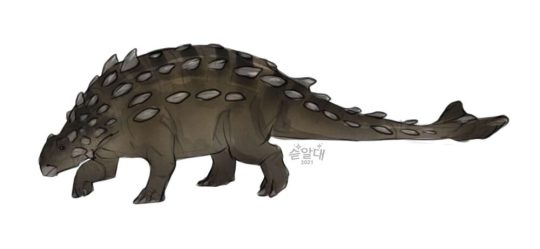
Anodontosaurus
Anodontosaurus — рід птахотазових динозаврів родини Анкілозаврові (Ankylosauridae). Вид існував у кінці крейдяного періоду (пізній кампан – ранній маастрихт, 72,8-67 млн років тому). Скам’янілі рештки знайдено в Канаді в провінції Альберта у відкладеннях формування Каньйон Підкови. Описаний по голотипу CMN 8530, що містить рештки черепа, броні та посткраніального скелета. Типовий та єдиний вид — Anodontosaurus…
Повний текст на сайті "Вимерлий світ":
https://extinctworld.in.ua/anodontosaurus/
#anodontosaurus#dinosaur#ornithischia#ankylosauridae#cretaceous#canada#alberta#north america#prehistoric planet#apple#david attenborough#bbc#paleoart#prehistoric#paleontology#science#illustration#prehistory#art#extinct#daily#fossils#tumblr#палеоарт#палеонтологія#ukraine#україна#арт#українська мова#ukrainian
2 notes
·
View notes